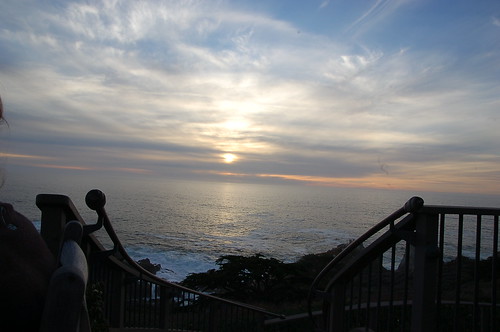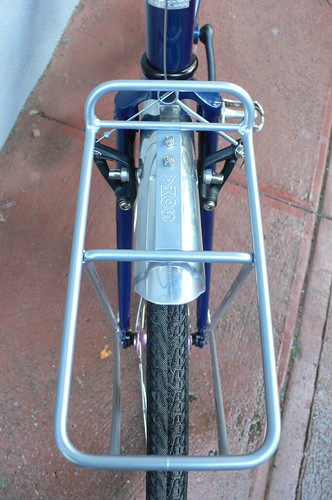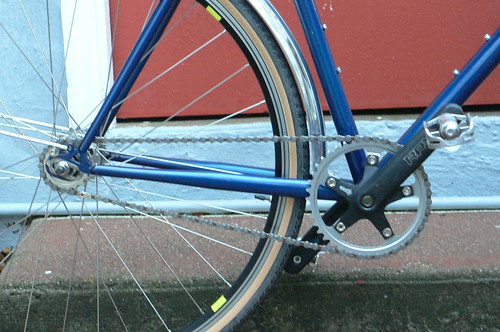I sold my fixed-gear bike earlier this year to make room for the incoming Kogswell and Ebisu. Soon after I picked up my Ebisu and built it up in March, I also unloaded my Rivendell Romulus because the P/R and the Ebisu cover Romulus's functions well. I had a wonderful riding season and really like both the Ebisu and the Kogswell.
I did really miss riding a fixed gear bike, though, especially as winter approaches and rain started to come down. So when I saw a fellow iBOB list member put a
Raleigh One Way up for sale, I contacted him. After some negotiation we reached an agreement on price. I sent the money out and 10 days later I got the frameset and a few other parts.
I came across the
Raleigh One Way as I was searching for a suitable but inexpensive fixed-gear frameset. I didn't want a track frames as they really don't provide adequate tire clearance and have no provisions for racks and fenders (and even brakes). Several single-speed specific roadish frames exist on the market--Soma Rush and Delancy, Surly Steamroller, Kona Paddy Wagon, and Gunnar Street Dogs--and they have various accommodations for brakes, fenders and racks. However, even the best of these frames can only accommodate 28mm tires with fenders. After riding my 650b bikes with 40mm tires on them all year, 28mm seems too skinny by comparison.
The only production single-speed specific frames I found that have good amount of braze-ons and good tire clearance are Rivendell Quickbeam,
On-one il Pompino (the bike I sold earlier), and
Raleigh One Way.
Rivendell Quickbeams are really nice, and if I have more disposable cash I would have gone to Walnut Creek and picked up a silver one when Grant and Co. released this last batch. Of the remaining two choices, the Raleigh has a nicer fork, and one that has more off-set leading to a lower-trail geometry suitable for carrying front loads. It is also more roadish than the Pompino, which has 135mm rear drop-out spacing. (after I purchased the One Way I came across the
IRO Phoenix, which also satisfy my criteria, and seems like a good production frameset).
My first impression of the One Way when I received the frame is that the deep dark blue color is really nice. As I unpacked the frame of wrapping materials, I began to notice how stout the tubes are--this is definitely an over-built steel frame. After riding mostly standard-size tubings on my geared bikes this year, the One Way will definitely provide a contrast in that department. I cleaned up the frame a little and stashed it away, as I have to wait for a few important parts to arrive to complete the build.
I try to use as many parts as I already have in the parts bin. The frameset package included frame, fork, headset, seatpost, and front brake. I rummage through my parts bin and came up with a rear brake, crank arms, track cog and lock ring, and tires and tubes. The SF Bike Expo Bike Swap took place after I bought the frameset, and I picked up brake levers, bottom bracket, chain ring bolts, and stem at the swap. I also got a 650c Mavic CXP22 rim thinking that it was 700c. I put it on Craigslist right the way and was able to find someone to swap rims with. Metin in Palo Alto had a set of 700c CXP22 rims and wanted a 650c rim for a tri-bike. I gave him $20 for the set in exchange for my lone 650c rim--it worked out well for me.
I shopped around for the remaining parts, and got good deals on many of them. I scored a pair of hubs from IRO Cycles, and found good deals for pedals, chains, freewheel, and fenders at Outside Outfitter (an online retailer). I bought the handlebar, spokes, racks, and water bottle cages at local bike shops.
I assembled the bike sans wheels, chain, rack, and fenders. I received the hubs today and will build the wheels up in the next day or two. Racks and fenders will go up after that.
I will post pictures and report on first impressions in the next post.
Note:
The link to Raleigh's website shows a 2009 One Way. The 2010 version is white, and uses a SRAM
Torpedo hub--a singlespeed hub that can become a fixed gear with a few turns of a screw. 2009 One Ways, incidentally, are on sale at REI.com at the moment for $630. You have to pay tax, but not shipping since you have to pick up at a REI store anyway. I like the frameset option as it gives me more flexibility to configure the bike to the way I want it to be.









